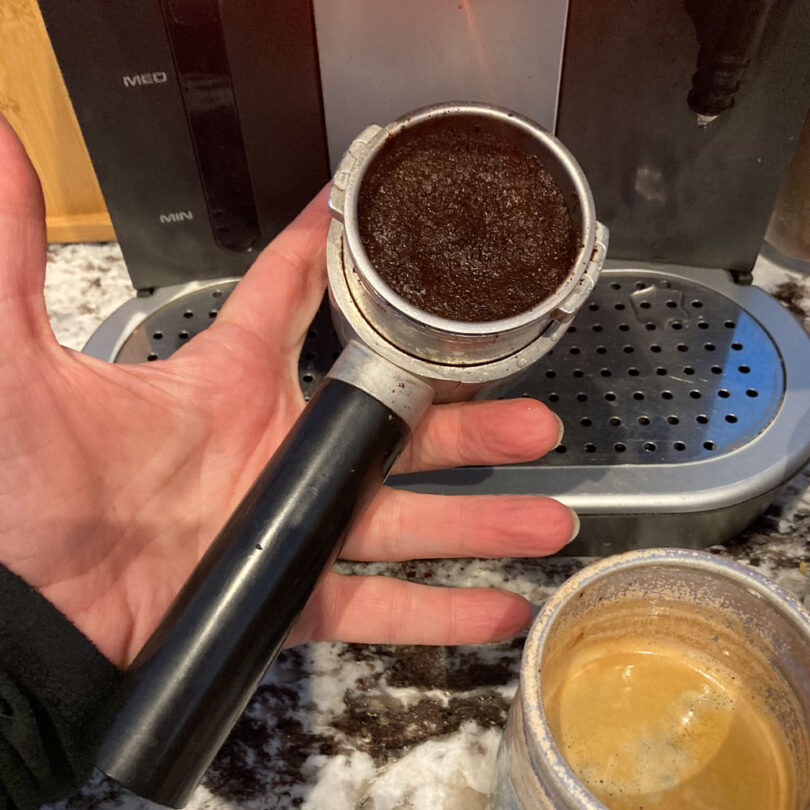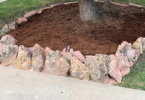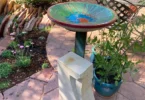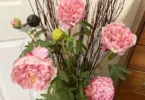Great Ideas for Reusing Those Old Used Coffee Grounds
Please don’t dump your coffee grounds in the trash or down the kitchen sink disposal! There are so many excellent uses for your daily (or in my case, multi-daily) used coffee grounds production.
Although coffee beans are highly acidic, once you brew coffee with them, the pH level of the grounds is reduced significantly. This leaves you with a product that is wonderfully bio-degradable and has properties and nutrients that are beneficial for a number of diverse uses.
#1 – Fertilize your Garden
Used Coffee Grounds contain many bioactive compounds that can help to enhance the soil in your lawn, flower garden or vegetable garden and provide nutrients to plants. As the material breaks down, used coffee grounds release nitrogen, an essential nutrient for green foliage growth. Coffee beans also contain minerals such as potassium, boron, calcium, copper, iron, magnesium, phosphorus, and zinc that many garden plants can use as nutrients for healthy growth. There are legitimate research studies to back this up.
The nutrients in spent coffee grounds also feed soil organisms. Earthworms actually eat them, but many other smaller living things in your soil can benefit from the used coffee grounds. Coffee grounds can contain certain trace elements that may help suppress varieties of plant disease-causing microbes.
Using Used Coffee Grounds in your Garden
To use coffee grounds as fertilizer, you can simply sprinkle them onto the soil surrounding your plants. Try not to dump too many used coffee grounds in one single area – they can clump up and create a crust on top of the soil if they are not evenly dispersed. Essentially, the used coffee grounds are just naturally composting and they release their goodness directly into your soil.
Using Used Coffee Grounds on your Lawn
This one is super easy! Just widely scatter the grounds over a section of your yard. This works particularly well if you do it just before you mow or just before the irrigation comes on, because it helps to disperse the particles. If you are bagging your lawn clippings and using them in your compost pile, coffee grounds are terrific for compost (more about that later in this article!) One note: the ground underneath evergreens tends to already be fairly acidic, so I avoid adding used coffee grounds to these areas.
Spread around Hydrangeas to Encourage Blue Color
If your Hydrangeas are already blue, the color should get more intense. If you have fairly colorless Hydrangeas, it will take some time, maybe a month to achieve a nice blue tone. If you have Pink Hydrangeas, you could try to change the color, but I personally love the pink ones! If you have more than one plant, you could amaze your neighbors with a variety of colors with carefully applied coffee grounds.
For hydrangeas, it is best to dig spent grounds into the soil a bit or cover them with some mulch. Coffee grounds are not good for pets, so digging them in is a better choice than sprinkling them on top. Also, this gets the nutrients closer to the roots and avoids any crusting action that the coffee grounds tend to create while they are breaking down.
Other Acid Loving Garden Plants
Vegetables that love a little acidic soil include Cabbage. Radishes and Carrots. Fruits like blueberries also crave a little acid. Other flowering plants that like acid (but the color will not be affected in the same way as hydrangeas) include Roses, Lilies, Holly, Rhododendrons and Azaleas.
Careful with House Plants!
Even if you have an acid loving house plant, don’t use this method indoors. You can quickly overwhelm an indoor plant in a small pot. It works outdoors because the coffee grounds are breaking down into nutrients because they are essentially composting in place. You don’t have enough sun, space, water and fresh air indoors to successfully break the coffee grounds for a house plant.
#2 – Deter Pests
Used coffee grounds contain Caffeine and two types of Diterpenes, all of which are toxic to many insects. Insects may also just be repelled by the odor. People have reported success with using used coffee grounds to deter ants or fly larvae. Simply sprinkle used coffee grounds in the area where you see activity – all around an anthill or where you see larvae.
I’ve also read reports that used coffee grounds that are spread around your yard as fertilizer also discourages cats from dropping by your yard. I can’t comment on this one because I fortunately do not have a visiting cat problem.
I’ve heard that some folks attempt to use scattered coffee grounds to deter deer from grazing their garden. Hmm. Perhaps this works with whitetail deer, but I’m thinking that almost nothing is going to stop a Colorado Mule Deer from eating the tops off of all your tulips! Better to plant stuff that tastes bad, like Daffodils if you are mountain-adjacent as I am. 😉
#3 – Enhance your Compost
If you are a backyard composter, good for you! You may already know that you can put used coffee grounds in your pile – and that they are considered “browns” in your ratio of green stuff to brown stuff. If you are not yet composting, consider that you can compost coffee grounds with other readily compostable items like vegetable and fruit scraps, egg shells, grass cuttings, leaves, dead-headed flower tops, and other vegetable waste from kitchen and garden. Don’t forget that indoor house plants can contribute to the pile when you are removing leaves that have gone brown, or the root ball from a plant that has died.
What you may not know is that used coffee grounds are particularly beneficial to your composting process. Studies like this one indicate that a higher percentage of spent coffee grounds can improve your compost:
The study tested spent coffee grounds as 0, 10, 20 and 40 percent of the total content of the compost and found improvements in the quality of the final product with the 40% value. Elsewhere, percentages of up to 20 percent of total compost volume have been reported as optimal for compost quality and effectiveness, which indicates that you could probably use up all of your own coffee grounds just through composting.
#4 – Neutralize Odors
Spent Coffee grounds can be used to counteract unwanted smells. Consider these ideas:
- Put a open topped container of spent coffee grounds in your refrigerator. Every couple of weeks you can toss the old ones in the compost or garden, then refresh the supply in the ‘fridge.
- Hang a cloth or tight mesh bag of used coffee grounds in your outdoor trash bin. Change every few weeks or if you notice any mold.
#5 – Remove Odors from Hands
Have you been chopping onions or garlic? Try adding some coffee grounds to your hand soap and scrub it around your fingers and cuticles to help remove the odor.
#6 – De-Icer for your Sidewalk
Instead of using Salt or other environmentally questionable ice melting products on your icy walkways, try sprinkling used coffee grounds. The nitrogen in the grounds can help to lower the freezing temperature, helping the ice to melt and evaporate faster. The coffee grounds left behind eventually make their way into your lawn or garden to compost and disperse their nutrients naturally. I also like the fact that coffee grounds won’t burn pet paws the way salt does.
When I tested this on my back patio, which gets NO SUN at all in the winter, it helped to some extent. The ice did melt faster in the areas I sprinkled. The grounds also made the top of the ice a little less slippery (although my espresso grounds are really finely chopped – drip coffee drinkers might have better results here). If you use them in an area that does get some sun, you might have the additional benefit of the dark color helping to absorb the sun’s warmth.
#7 – Scrub Your Pans
Used Coffee Grounds work great as a scrubbing agent when cleaning pots and pans with greasy or burned-on debris. Just sprinkle in some grounds along with a dab of Dawn Dishwashing liquid and a splash of water to mix everything up. Scrub away!
#8 – Scrub Your Sink
Just like the pots & pans above, your kitchen sink can benefit from a coffee grounds scrub. The process is the same: sprinkle coffee grounds and a bit of Dawn Dishwashing liquid on your kitchen sponge and give all the sink surfaces an nice but gentle scouring.
#9 – Scrub Your Scalp
Used Coffee Grounds actually make a nice ingredient for exfoliating your scalp when you’re showering. Caffeine that is found in the spent grounds is purported to being beneficial for hair follicles – to the extent that caffeine is sometimes added to commercial products to promote hair growth. You can judge for yourself by reading this scientific study effects of caffeine on hair shaft elongation.
Another effect of coffee grounds is that it has a slight darkening action, so scrubbing your scalp can also lend some brown color to your hair. This doesn’t have the same effects as permanent hair dye, but it can work similar to a mild rinse that makes your hair slightly browner – depending of course on the color of your hair. The longer you leave it in and the more frequently that you do it, the more pronounced color change.
Scalp scrubs work best with very finely ground coffee. If your grounds are fairly coarse, you may want to run them through a food processor or pulse grinder before making your scrub.
Scalp Scrub Method #1
I just mix in about 2 teaspoons of espresso grounds into my regular hair conditioner. I rub it into my scalp, then distribute the conditioner through the rest of my hair. I leave it on for 3-4 minutes, then rinse throughly. It will take longer than usual to get all of the coffee grounds to rinse out when you are done conditioning.
Scalp Scrub Method #2
In the shower, condition your hair as usual – disperse the conditioner through all of your hair. Now take about 1 teaspoon of coffee grounds & mix with a little more conditioner. Now rub this conditioner just into the hair along your hairline. This method works best for people like me that have lighter hair framing my face, but the hair in back doesn’t really need to get darker. Rinsing does not take as long with this method.
With just two applications, I can see a very slight color change with my hair, but it was fairly light to start with. The nice thing is that this coloration is very gradual and you can control how much you get through frequency of use. Be sure to discontinue scrubs if you notice any dryness or brittleness. I haven’t noticed any yet and will update this post if I do.
#10 – Scrub Your Feet
Used Coffee grounds make a really nice exfoliant for your feet – especially calloused areas around your heels. For this purpose, a more coarsely ground bean is beneficial, but you can use what you have. I like to mix a small amount of grounds into water based body butter – mine has shea butter and coconut oil in it. Scrub it in with a nice exfoliant scrubbing cloth. loofa, or skin brush, then rinse throughly. After drying my feet, I finish with the original body butter, but without the coffee.
These exfoliant wash cloths are a nice size, have a 'scrubby side' and a 'smoother side' and have a little loop in one corner so that you can easily hang them up to dry. Sold in packages of 5 cloths, so you can use one as your 'coffee cloth' and the others for other products (or share with family members).
#11 – Add Flavor to Baked Goods
A small amount of ground coffee can be a nice flavoring for baked goods – especially chocolatey items. Muffins, brownies, bars, cakes and even frosting can be enhanced with a little coffee grounds. My beans are ground for espresso, but if you have grounds that are more coarse (pour overs and such), you may want to grind them finer before adding to batter.
#12 – Add Flavor to Meat Marinades and Rubs
A bit of coffee grounds can be used as a component of rubs used for meats or for marinades. The acidic nature of the coffee can contribute to tenderizing the meat. There are a number of recipes available that sound delicious. While I am not going to repeat those here, one with coffee grounds and coarse salt, brown sugar, garlic, black pepper, and cayenne pepper caught my attention!
#13 – Let your Garbage Disposal Have Some
Every once in a while, don’t feel bad if you send some coffee grounds down the kitchen disposal. It can benefit from the scrubbing and deodorization, just like many other things in your household.
Saving, Storing and Preparing Used Coffee Grounds
Coffee Grounds get moldy if you try to store them wet. I suppose you could freeze them, but it’s really simple just to dry them.
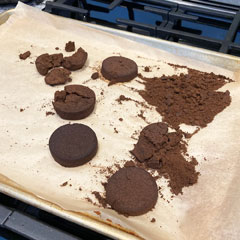
I just empty my espresso porta-filter onto a cookie sheet with a liner of parchment paper. If you use paper filters, just drop the entire filter onto your collection sheet. The paper filters can be composted when they are dry.
I let my cookie sheet sit in my oven so that it’s off the counter. When the coffee grounds are completely dry, I start using them. You could store them in a cool dry place – but personally I never seem to have enough of them to store. If your planned purpose is to compost, there is no need to dry the grounds – just add them immediately to your compost mix.
You may have noticed from my photo, that my Parchment Paper is brown. I prefer un-bleached products when I can get them, and this is the brand I use in my kitchen. Even little actions can help contribute to being eco-sensitive.
When you need a finer grind
I use a really nice burr grinder for my espresso beans. Trying to put the used coffee grounds through the grinder a second time is really not a thing. I have a small food processor, and that sort of works for making a finer powder from used grounds. The best thing I’ve found for this purpose is a entry level coffee bean blade grinder. I often see these at thrift shops for a few bucks, but they are so inexpensive that you may just want to save time and gas money by picking one up new. They can also be used to chop up other dry things like spices or herbs.
A small and simple blade grinder for used coffee beans (or even fresh coffee bean), spices, herbs, nuts or other dry material.
Other Ways to Reuse Coffee Grounds
Perhaps some of these reuse options will click with you, and sometimes life is just too busy to be able to do all the extra things you would like to. Frankly, we still want that coffee in the morning, so here are some ideas of how some other people might get good use out of your stash of used coffee grounds. Just reach out on a local social platform like Nextdoor or Facebook, or post a ‘Free’ listing on Craigslist. You just might make a new friend with one of the type of people in this list:
- Fiber Artists sometimes use coffee grounds to dye things brown
- People who grow mushrooms love to use coffee grounds. Coffee grounds make a particularly good strata for mushroom farming.
- Worm Farming – earthworms can consume coffee grounds and benefit greatly from them.
- Home Composters – folks that are especially keen on home composting love to have extra coffee grounds for their “browns”, since increasing the percentage of coffee grounds can improve the results of composting their other materials. If you are not into composting yourself, make a composting friend. Maybe they will even share some of the compost with you later.
Not Enough Coffee Grounds?
Now that you’ve got all sorts of ideas about what you’d like to use coffee ground for, are you finding that you may not have enough of them? Sometimes local Coffee Shops have programs to reuse all the spent coffee that they go through. Ask a local Barista!
Don’ts for Used Coffee Grounds
As useful as this waste product is, keep in mind a few things that you don’t want to do:
- Use un-brewed coffee grounds for most of these tasks. Before brewing, the ground up coffee is too acidic, and besides that, coffee is expensive! The only exception might be flavoring baked goods or meat marinades – those recipes sometimes call for ground coffee before it has been brewed.
- Don’t let it get moldy. Then the only purpose for it is to compost it. Follow the instructions for drying and storing your precious used coffee grounds.
- Don’t apply directly to house plants. Indoor conditions are not conducive to breaking down coffee grounds in a way that the plants can use them successfully.
- Pay attention to see If your dogs try to eat any coffee grounds used in your garden. If so, you’ll want to dig the grounds into the soil – or disperse the coffee grounds widely over any lawn areas.


